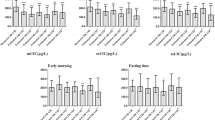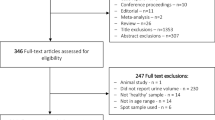Abstract
Objective: To examine the day-to-day and within-day variation in urinary iodine excretion and the day-to-day variation in iodine intake.
Design: Collection of consecutive 24-h urine samples and casual urine samples over 24 h.
Setting: The study population consisted of highly motivated subjects from our Institute.
Subjects: Study 1: Ten healthy subjects (seven females and three males) aged 30–46 y. Study 2: Twenty-two healthy subjects (9 males and 13 females) aged 30–55 y.
Methods: Study 1: 24-h urine samples were collected for four consecutive days. Study 2: Each urine voided over 24 h was collected into separate containers. In both studies dietary records were kept.
Main outcome measures: Twenty-four-hour urinary iodine excretion, 24-h urinary iodine excretion estimated as I/Cr*24 h Cr and as a concentration in casual urine samples.
Results: Study 1: Both iodine excreted in 24-h urine and iodine intake varied from day-to-day. Iodine excretion correlated with iodine intake (r=0.46, P=0.01). Iodine intake (mean 89±6.5 μg/d) was not significantly different from iodine excretion (mean 95±5.3 μg/d). Study 2: Twenty-four hour iodine excretion estimated as I/Cr*24 h Cr from the morning urine sample was significantly lower than actual 24-h iodine excretion, whereas 24-h iodine excretion estimated as I/Cr*24 h Cr from the first sample after the morning sample and the last sample before the subjects went to bed was not significantly different from actual 24-h iodine excretion. Twenty-four-hour urine excretion estimated as a concentration was lower than actual 24-h iodine excretion in casual urine taken at any time of the day.
Conclusions: For determination of iodine status in an individual, more than one 24-h urine sample must be used. The use of the I/Cr ratio in casual urine samples is a usable measure of iodine status if corrected for the age- and sex-adjusted 24-h creatinine excretion. Further, the study suggests that fasting morning urine samples would underestimate iodine status in this population.
Sponsorship: The study was supported by a grant from the 1991 Farmacy Foundation (Denmark).
Contributors: Lone Banke Rasmussen and Lars Ovesen contributed to design, carried out the study, and wrote the paper. Erik Christiansen made the analyses.
Guarantor: Lone Banke Rasmussen.
Similar content being viewed by others
Author information
Authors and Affiliations
Rights and permissions
About this article
Cite this article
Rasmussen, L., Ovesen, L. & Christiansen, E. Day-to-day and within-day variation in urinary iodine excretion. Eur J Clin Nutr 53, 401–407 (1999). https://doi.org/10.1038/sj.ejcn.1600762
Received:
Revised:
Accepted:
Published:
Issue Date:
DOI: https://doi.org/10.1038/sj.ejcn.1600762
- Springer Nature Limited
Keywords
This article is cited by
-
Salivary iodine concentration in pregnant women and its association with iodine status and thyroid function
European Journal of Nutrition (2024)
-
Exploration of thyroglobulin as a biomarker of iodine status in iodine-sufficient and mildly iodine-deficient pregnant women
European Journal of Nutrition (2023)
-
Is the urinary iodine/creatinine ratio applicable to assess short term individual iodine status in Chinese adults? Comparison of iodine estimates from 24-h urine and timed-spot urine samples in different periods of the day
Nutrition & Metabolism (2022)
-
The Status of Iodine Nutrition after Removing Iodized Salt in High Water Iodine Regions: a Cross-sectional Study in China
Biological Trace Element Research (2022)
-
The Joint Role of Iodine Status and Thyroid Function on Risk for Preeclampsia in Finnish Women: a Population-Based Nested Case-Control Study
Biological Trace Element Research (2021)




